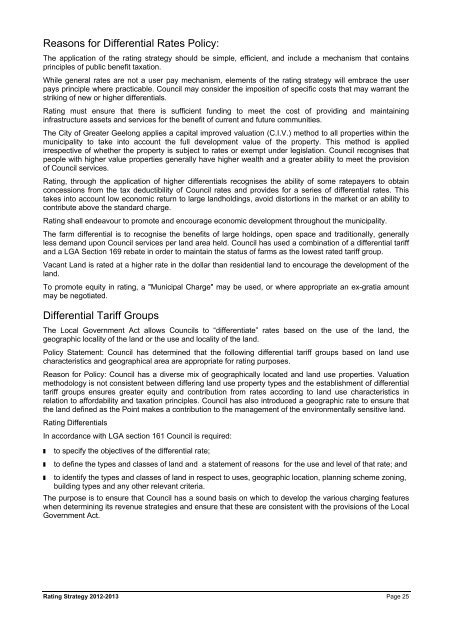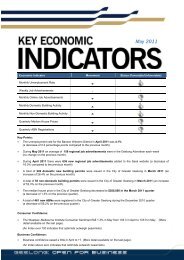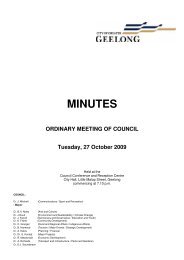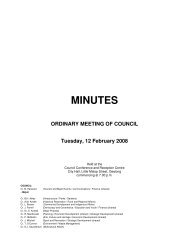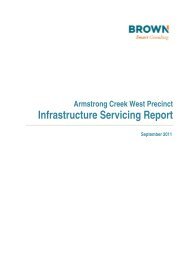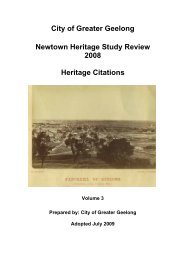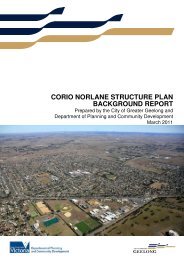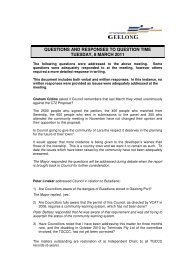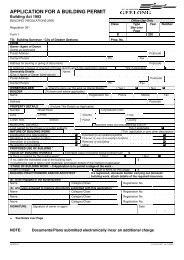CITY OF GREATER GEELONG 2012-2013 Rating StRategy
CITY OF GREATER GEELONG 2012-2013 Rating StRategy
CITY OF GREATER GEELONG 2012-2013 Rating StRategy
Create successful ePaper yourself
Turn your PDF publications into a flip-book with our unique Google optimized e-Paper software.
Reasons for Differential Rates Policy:<br />
The application of the rating strategy should be simple, efficient, and include a mechanism that contains<br />
principles of public benefit taxation.<br />
While general rates are not a user pay mechanism, elements of the rating strategy will embrace the user<br />
pays principle where practicable. Council may consider the imposition of specific costs that may warrant the<br />
striking of new or higher differentials.<br />
<strong>Rating</strong> must ensure that there is sufficient funding to meet the cost of providing and maintaining<br />
infrastructure assets and services for the benefit of current and future communities.<br />
The City of Greater Geelong applies a capital improved valuation (C.I.V.) method to all properties within the<br />
municipality to take into account the full development value of the property. This method is applied<br />
irrespective of whether the property is subject to rates or exempt under legislation. Council recognises that<br />
people with higher value properties generally have higher wealth and a greater ability to meet the provision<br />
of Council services.<br />
<strong>Rating</strong>, through the application of higher differentials recognises the ability of some ratepayers to obtain<br />
concessions from the tax deductibility of Council rates and provides for a series of differential rates. This<br />
takes into account low economic return to large landholdings, avoid distortions in the market or an ability to<br />
contribute above the standard charge.<br />
<strong>Rating</strong> shall endeavour to promote and encourage economic development throughout the municipality.<br />
The farm differential is to recognise the benefits of large holdings, open space and traditionally, generally<br />
less demand upon Council services per land area held. Council has used a combination of a differential tariff<br />
and a LGA Section 169 rebate in order to maintain the status of farms as the lowest rated tariff group.<br />
Vacant Land is rated at a higher rate in the dollar than residential land to encourage the development of the<br />
land.<br />
To promote equity in rating, a "Municipal Charge" may be used, or where appropriate an ex-gratia amount<br />
may be negotiated.<br />
Differential Tariff Groups<br />
The Local Government Act allows Councils to “differentiate” rates based on the use of the land, the<br />
geographic locality of the land or the use and locality of the land.<br />
Policy Statement: Council has determined that the following differential tariff groups based on land use<br />
characteristics and geographical area are appropriate for rating purposes.<br />
Reason for Policy: Council has a diverse mix of geographically located and land use properties. Valuation<br />
methodology is not consistent between differing land use property types and the establishment of differential<br />
tariff groups ensures greater equity and contribution from rates according to land use characteristics in<br />
relation to affordability and taxation principles. Council has also introduced a geographic rate to ensure that<br />
the land defined as the Point makes a contribution to the management of the environmentally sensitive land.<br />
<strong>Rating</strong> Differentials<br />
In accordance with LGA section 161 Council is required:<br />
to specify the objectives of the differential rate;<br />
to define the types and classes of land and a statement of reasons for the use and level of that rate; and<br />
to identify the types and classes of land in respect to uses, geographic location, planning scheme zoning,<br />
building types and any other relevant criteria.<br />
The purpose is to ensure that Council has a sound basis on which to develop the various charging features<br />
when determining its revenue strategies and ensure that these are consistent with the provisions of the Local<br />
Government Act.<br />
<strong>Rating</strong> Strategy <strong>2012</strong>-<strong>2013</strong> Page 25


